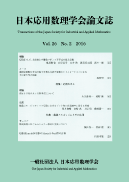Volume 4, Issue 3
Displaying 1-11 of 11 articles from this issue
- |<
- <
- 1
- >
- >|
-
Article type: Cover
1994Volume 4Issue 3 Pages Cover1-
Published: September 15, 1994
Released on J-STAGE: April 08, 2017
Download PDF (27K) -
Article type: Cover
1994Volume 4Issue 3 Pages Cover2-
Published: September 15, 1994
Released on J-STAGE: April 08, 2017
Download PDF (27K) -
Article type: Article
1994Volume 4Issue 3 Pages i-
Published: September 15, 1994
Released on J-STAGE: April 08, 2017
Download PDF (189K) -
Article type: Article
1994Volume 4Issue 3 Pages 211-228
Published: September 15, 1994
Released on J-STAGE: April 08, 2017
Download PDF (978K) -
Article type: Article
1994Volume 4Issue 3 Pages 229-234
Published: September 15, 1994
Released on J-STAGE: April 08, 2017
Download PDF (403K) -
Article type: Article
1994Volume 4Issue 3 Pages 235-250
Published: September 15, 1994
Released on J-STAGE: April 08, 2017
Download PDF (1303K) -
Article type: Article
1994Volume 4Issue 3 Pages 251-258
Published: September 15, 1994
Released on J-STAGE: April 08, 2017
Download PDF (448K) -
Article type: Article
1994Volume 4Issue 3 Pages 259-274
Published: September 15, 1994
Released on J-STAGE: April 08, 2017
Download PDF (1064K) -
Article type: Appendix
1994Volume 4Issue 3 Pages App1-
Published: September 15, 1994
Released on J-STAGE: April 08, 2017
Download PDF (12K) -
Article type: Cover
1994Volume 4Issue 3 Pages Cover3-
Published: September 15, 1994
Released on J-STAGE: April 08, 2017
Download PDF (26K) -
Article type: Cover
1994Volume 4Issue 3 Pages Cover4-
Published: September 15, 1994
Released on J-STAGE: April 08, 2017
Download PDF (26K)
- |<
- <
- 1
- >
- >|
